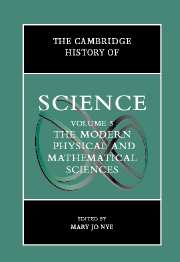Book contents
- Frontmatter
- Introduction: The Modern Physical and Mathematical Sciences
- Part I The Public Cultures of the Physical Sciences After 1800
- Part II Discipline Building in the Sciences: Places, Instruments, Communication
- Part III Chemistry and Physics: Problems Through the Early 1900s
- 11 The Physical Sciences in the Life Sciences
- 12 Chemical Atomism and Chemical Classification
- 13 The Theory of Chemical Structure and its Applications
- 14 Theories and Experiments on Radiation from Thomas Young to X Rays
- 15 Force, Energy, and Thermodynamics
- 16 Electrical Therory and Practice in the Nineteenth Century
- Part IV Atomic and Molecular Sciences in the Twentieth Century
- Part V Mathematics, Astronomy, and Cosmology Since the Eighteenth Century
- Part VI Problems and Promises at the End of the Twentieth Century
- Index
- References
12 - Chemical Atomism and Chemical Classification
from Part III - Chemistry and Physics: Problems Through the Early 1900s
Published online by Cambridge University Press: 28 March 2008
- Frontmatter
- Introduction: The Modern Physical and Mathematical Sciences
- Part I The Public Cultures of the Physical Sciences After 1800
- Part II Discipline Building in the Sciences: Places, Instruments, Communication
- Part III Chemistry and Physics: Problems Through the Early 1900s
- 11 The Physical Sciences in the Life Sciences
- 12 Chemical Atomism and Chemical Classification
- 13 The Theory of Chemical Structure and its Applications
- 14 Theories and Experiments on Radiation from Thomas Young to X Rays
- 15 Force, Energy, and Thermodynamics
- 16 Electrical Therory and Practice in the Nineteenth Century
- Part IV Atomic and Molecular Sciences in the Twentieth Century
- Part V Mathematics, Astronomy, and Cosmology Since the Eighteenth Century
- Part VI Problems and Promises at the End of the Twentieth Century
- Index
- References
Summary
During the past decades, the historiography of nineteenth-century chemistry has become increasingly complex and at the same time more interesting. Rising on the sound “internalistic” foundations laid by Aaron J. Ihde’s The Development of Modern Chemistry (1964) and, of course, by James R. Partington’s A History of Chemistry (four volumes, 1961–1970), the edifice of more recent historiography depicts chemistry as an endeavor in close interaction with the cultural and intellectual currents of that time. Departing from the question of the disciplinary identity of chemistry during the nineteenth century and thus joining “the separate analyses of schools, disciplines, and traditions into an integrated analytical matrix,” Mary Jo Nye has with a sure hand sketched out the framework of this chemical edifice. As reflected in her book, new problems have moved to the forefront, among them the question of the disciplinary development of chemistry and its subdisci-plines, such as biochemistry, stereochemistry, and physical chemistry, as well as questions of the emergence of scientific schools and of science policy in general. Last but not least are the questions of the metaphysical background and of the internal discourses among chemists. In this context, two questions are of eminent importance: What is “chemical” in chemistry, that is, what distinguishes chemistry from its neighbor sciences? And how does chemistry arrange the objects of its scientific experiences?
CHEMICAL VERSUS PHYSICAL ATOMS
One may well say that it is the notion of units of matter showing certain measurable relations of their weight and possessing certain characteristics to explain the specificity of chemical reactions (that is, the notion of “chemical atomism”) that distinguished chemistry from its close relative, physics. This may sound a little strange, as we are used to seeing atoms as the same entities in all sciences. From the time of Democritus (ca. 410 b.c.) up to the first decades of the nineteenth century, atoms were considered to be little indivisible lumps of matter, which, when forming compounds, are attached to one another either by their respective shapes or by “affinities.”
- Type
- Chapter
- Information
- The Cambridge History of Science , pp. 237 - 254Publisher: Cambridge University PressPrint publication year: 2002

